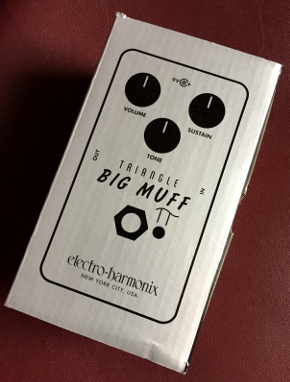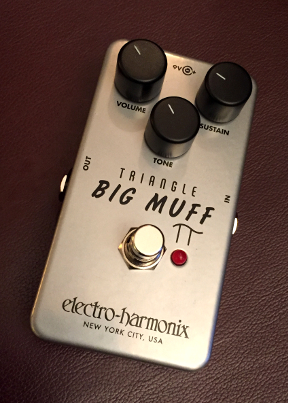2018 Electro-Harmonix Triangle Big Muff Reissue

01/14/2019
SOME FUZZY STUFF
It's the new year and I am already hard at work, patrolling the pathways in the big bad world of guitar searching for information for you! Info and opportunity come from diverse and varied sources: Towards the end of 2018 the first reviews of the new Electro Harmonix Triangle Big Muff Pi Fuzz Reissue had begun to trickle out and videos were surfacing. It looked like just the fuzz for me so I put it on my Christmas list. Then, glory and trumpets, my lovely wife provided me the subject for this discussion when she gave me the pedal as a gift! Now, I won't try to bluff my way through this, acting as though I am a connoisseur of Muffs - we'll have to leave that to the hard core users. This is, in fact, my very first Muff Fuzz. My last fuzz was a Heathkit “Distortion Booster" I got in the 1970s that somehow became lost from my kit over time. However, I have been listening to others use their early-design Muff Fuzzes since 1971 and have filed away several touchpoint recordings that stood out along the way. A few of my key Big Muff tones include:
- The revolutionary guitar solo on the Carpenters' 1972 hit, "Goodbye to Love," played by Tony Peluso with a serrated pick on an ES-335 that was plugged into an original Triangle Big Muff that was run directly into the console at A&M Records Studio
- David Gilmour's lead tone on the song "Sorrow" from the Pulse concerts played on a Strat. I’ve been fascinated with reproducing this sound, even thought he used a Pete Cornish P1 pedal, which is a clone of a Big Muff "Ram's Head.” The Ram’s Head was the next version of the Muff after the initial Triangle. You can't even start without a fuzz.
- Robert Fripp's exotic lead guitar tone stylings on Fripp and Eno's piece, "Evening Star," from the album by the same name
Soooo, the point of this present article is to consider the modern Electro Harmonix Triangle Big Muff Pi Reissue based upon its ability to reproduce a select group of smooth tones I know and want to reproduce.

The Original
HISTORY OF THE TRIANGLE BIG MUFF
Since we are delving in the history of this pedal, it behooves us to realize that there have been multiple versions of the Muff over the last fifty years. In fact, you might even be forgiven for thinking that there were "Days of the week" Muffs because there have been thirty-four (count 'em) EHX versions alone between the beginning of production in 1969 and the beginning of development of this reissue in 2017. The “Triangle” version was the first production BIG Muff and received its popular name later because of the knob positions which formed a triangle on the front panel of that first version. And finally, there wasn’t even a single circuit specification throughout production of the Triangle. As parts became hard to source they were replaced with others, making the design a moving target. The basic design is a multistage clipping circuit involving four silicon transistors and two silicon diodes in clipping circuits. These are arranged as a preamp, followed by a clipping stage, followed by another clipping stage, followed by the the tone network, and finally followed by a final gain makeup preamp. Electro Harmonix founder Mike Matthews commissioned the design from his electronics designer, Bell Labs Engineer Robert (Bob) Myer. When Mike received the basic circuit back from Bob he loved its long sustain but felt that it was a tad raspy. Mike spent a while tweaking the filter section to refine the pedal and give it its final tone and feel, a tone that has been described as warm, musical, and “like a cello.” The original Big Muff premiered in the big box that gave it the name, listing at $39.95. Over time these original pedals have increasd in price to over $600 on the vintage market, leading to a flourishing aftermarket in boutique clones starting around $199.

THIS MODERN, MODERN WORLD
This modern Triangle reproduction serves as the fiftieth anniversary celebration of the Big Muff. Development began with an examination of a group of original Triangle Muff examples owned by vintage Muff aficionados. Mike narrowed down the field to a single example that best represented the sound of the original. The recreated Triangle is packed into a robust, nano-sized small box with a status LED and true bypass. Incidentally, the triangle of knobs on this reissue is inverted when compared to the original, probably so that the standard predrilled EHX enclosure can be used. The pedal offers dual power via an internal 9v battery or external 9vdc power supply via a standard center-negative barrel connector and draws about 2.2ma. The street price is $99, which is practically suspiciously inexpensive in the pedal world.
HOW DOES IT WORK?
The Triangle Big Muff Pi Reissue is a pretty straightforward pedal:
The tone knob is a dual control that adjusts both a low-pass and high-pass filter. As you turn the knob clockwise, the frequency of the high-pass and low pass filters both move up. As you turn the knob counterclockwise, the cutoff frequency of the high-pass and low pass filters move down. That makes it sort of a rotary bandpass, doesn't it? As a result, there are all sorts of nifty tones available as you sweep it but it will always add up to a compromise between the two. Got it? The Sustain control does indeed increase the sustain and saturation of the pedal as you crank it towards the right. The Volume adjusts the pedal's output when the pedal is engaged to either match the bypass level or kick the front-end of your amp with a generous gain boost.
Simple! No?
SO... WHAT ARE THE RESULTS?
Even at low Sustain settings this little guy rounds off the attack and gives the guitar a nice, smooth cello-like tone. As you crank up the Sustain control, the Triangle imparts a lovely, silky sustain that adds authority to every note... much like a dimed amp. We are talking abouts gobs and gobs and gobs of thick, gooey sustain. The tactile feel that it imparts is absolutely marvelous, and that is vital. There's no question what Fender players of the period were chasing: they wanted to change the plinkiness of a Fender into a fat, authoritative single-string lead machine, and this thing does it in spades. With a Fender, the guitar's tone control sort of selects how much "snark" the pedal's tone has. The overall effect is of a sweet, velvety-smooth sheen layed over the sound of your guitar. Does that description help? Probably not. The English language is starved for aural descriptors that really convey guitar's tone. Now, I'll freely admit that I prefer smoother, sweeter fuzzes over razzy or grindy ones that sound like an enraged bench grinder. This silicon-based circuit has just that. You can use the pedals Tone control to select how much you want you guitar to cut through a band or pull back on it to add lower midrange and note authority. It isn’t quite like some fuzzes that get totally saturated by humbuckers - there's plenty of range available to make it useful with them. At this point I've run two Les Pauls, an ES-335, an SG, a Tele, and a G&L S-500 hot Strat into the pedal and it offered something useful for all. Obviosly, the brighter the guitar, the more articulate and snarky the pedal will sound.
- I often find myself below one o'clock on the Tone to smooth out the buzz. With a single-coil guitar I might even go even lower in order to get some girth and cut the snark.
- I often find myselfright beyond noon on the Sustain to keep it from getting too thick. There's plently left if I want that '70s infinite sustain. And oh, will the Triangle ever sustain.
- I often find myself on the left-hand side of the Volume, below ten o'clock, so it isn’t too loud. This thing offers quite a bit of output gain.
Choose a Strat, adjust the pedal's tone and sustain, add the right technique and feel, and you can easily get Gilmour's lead tone for the intro from the Pulse version of the song "Sorrow." It's got loads of girth and sustain. A great bonus is that the lead sound from "Comfortably Numb" at that same concert is also right there waiting for you. You might add some midrange bite on your amp for articulation. Spin the Tone control to the right and you've got the grindy tone from the album version of "Sorrow." With an ES-335 you can get Justin Hayward's lead sounds from the early '70s, such as those on The Moody Blues Seventh Sojourn album or Justin Hayward's & John Lodge's Bluejays album. Now, John's originals were done with a Marshall Supafuzz that was virtually identical to the Sola Sound Tone Bender MkII that only had three transistors. And yes, with an ES-335, the pedal can reproduce the lead sound Tony Peluso got on the Caprpenters "Goodbye to Love." This anniversary pedal plays quite well into my practice of staying behind the leading edge but I might have overplayed that this time by, say, fifty years. But truth be told, this new edition of the classic Big Muff offers exactly the sounds I hoped it would and is a welcome addition to my kit.
To my lovely wife: Thanks for the pedal, sweetheart!
If you want more information and a deeper look at the recreation of this pedal, taxi right on over to Kit Rae's excellent Big Muff Pi page, HERE , and look up the Triangle Big Muff Pi Reissue. Kit actually supplied some of the original Triangles to Mike Matthews for the recreation!!!
ELECTRO HARMONIX TRIANGLE MUFF PAGE
= =
=



